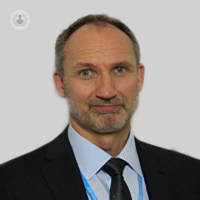All about thoracic aortic aneurysms
Written by:Aortic aneurysms are a dilation/widening of the aorta, the largest blood vessel in the human body. In the chest it mainly affects the part of the aorta close to the heart, but can also extend to the aortic arch and the descending aorta. Close to the heart, the dilation of the aorta can also result in a leakage of the aortic valve, which is mounted inside. Our expert cardiothoracic surgeon Professor Wendler explains more...

What are the symptoms and causes?
Patients with aortic aneurysms often do not complain about specific symptoms, but if their aortic valve is affected they are likely to notice shortness of breath during exercise and possibly chest pain. Most importantly, when aortic aneurysms in the chest reach a diameter of more than 5cm, patients are at risk of severe complications, which are often fatal. Aneurysms run in families, if a family history shows mysterious fatalities over generations, a medical assessment is needed.
How is it treated?
Aortic aneurysms can be very safely operated on. In general the surgeon replaces the diseased part of the aorta with a synthetic tube prosthesis. In cases where the aortic valve is affected, the aortic valve needs to be operated on at the same time. Often the native heart valve can be preserved. As the risk of an aortic aneurysm, if untreated is very high and the risk of surgery is very low, even patients without symptoms should have surgery for prognostic reasons as soon as aneurysms reach a certain diameter.
Minimally-invasive techniques
The most modern way to operate is using minimally-invasive surgical techniques. This includes the use of small, limited openings, keyhole operations and other surgical techniques which reduce the risk of stroke and other neurological complications. One significant advantage is for patients who are also affected by a leakage of the aortic valve in addition to the thoracic aortic aneurysm. In conventional surgery, the aortic valve is replaced. Now, usually only the aorta is replaced and the aortic valve is repaired. This avoids blood thinning treatment and possible heart valve prosthesis failure in the future.



